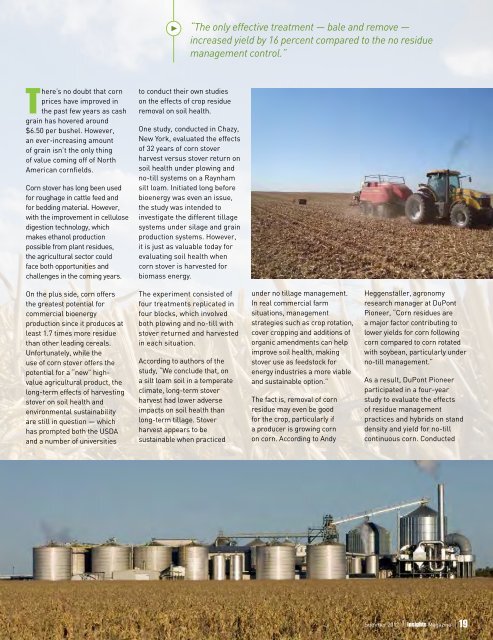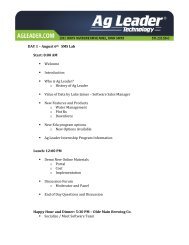You also want an ePaper? Increase the reach of your titles
YUMPU automatically turns print PDFs into web optimized ePapers that Google loves.
“The only effective treatment — bale and remove —increased yield by 16 percent compared to the no residuemanagement control.”There’s no doubt that cornprices have improved inthe past few years as cashgrain has hovered around$6.50 per bushel. However,an ever-increasing amountof grain isn’t the only thingof value coming off of NorthAmerican cornfields.Corn stover has long been usedfor roughage in cattle feed andfor bedding material. However,with the improvement in cellulosedigestion technology, whichmakes ethanol productionpossible from plant residues,the agricultural sector couldface both opportunities andchallenges in the coming years.to conduct their own studieson the effects of crop residueremoval on soil health.One study, conducted in Chazy,New York, evaluated the effectsof 32 years of corn stoverharvest versus stover return onsoil health under plowing andno-till systems on a Raynhamsilt loam. Initiated long beforebioenergy was even an issue,the study was intended toinvestigate the different tillagesystems under silage and grainproduction systems. However,it is just as valuable today forevaluating soil health whencorn stover is harvested forbiomass energy.On the plus side, corn offersthe greatest potential forcommercial bioenergyproduction since it produces atleast 1.7 times more residuethan other leading cereals.Unfortunately, while theuse of corn stover offers thepotential for a “new” highvalueagricultural product, thelong-term effects of harvestingstover on soil health andenvironmental sustainabilityare still in question — whichhas prompted both the USDAand a number of universitiesThe experiment consisted offour treatments replicated infour blocks, which involvedboth plowing and no-till withstover returned and harvestedin each situation.According to authors of thestudy, “We conclude that, ona silt loam soil in a temperateclimate, long-term stoverharvest had lower adverseimpacts on soil health thanlong-term tillage. Stoverharvest appears to besustainable when practicedunder no tillage management.In real commercial farmsituations, managementstrategies such as crop rotation,cover cropping and additions oforganic amendments can helpimprove soil health, makingstover use as feedstock forenergy industries a more viableand sustainable option.”The fact is, removal of cornresidue may even be goodfor the crop, particularly ifa producer is growing cornon corn. According to AndyHeggenstaller, agronomyresearch manager at DuPontPioneer, “Corn residues area major factor contributing tolower yields for corn followingcorn compared to corn rotatedwith soybean, particularly underno-till management.”As a result, DuPont Pioneerparticipated in a four-yearstudy to evaluate the effectsof residue managementpractices and hybrids on standdensity and yield for no-tillcontinuous corn. ConductedSummer 2012 | Insights Magazine | 19
















